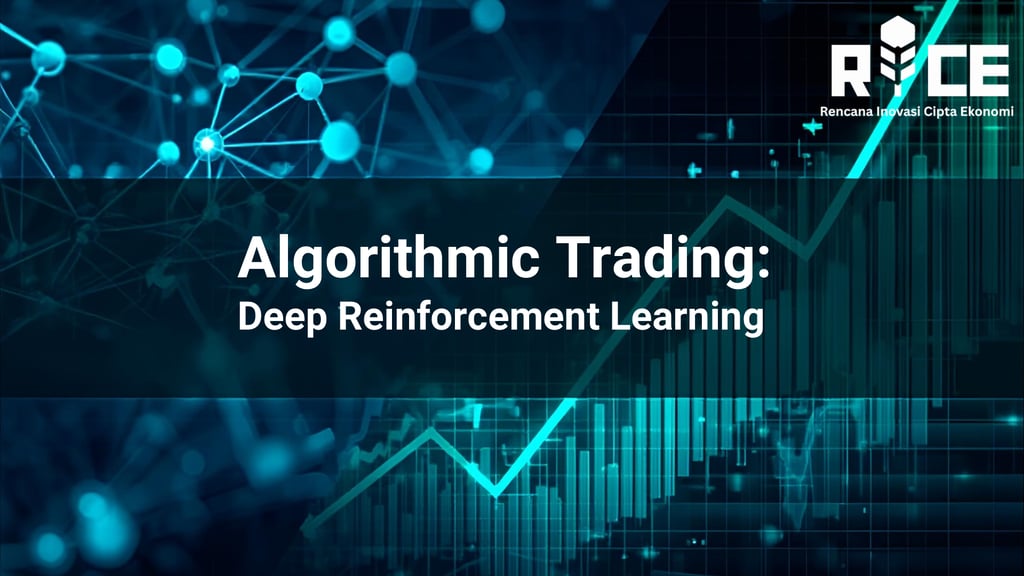Algorithmic Trading: Deep Learning vs. Reinforcement Learning – Which Path Leads to Higher Alpha?
Discover unique strengths, challenges, and how a synergistic approach can unlock higher alpha in dynamic financial markets.
INDUSTRIES
Rice AI (Ratna)
11/4/20257 min read


In the rapidly evolving landscape of algorithmic trading, a critical question emerges for quantitative strategists: Which paradigm, Deep Learning (DL) or Reinforcement Learning (RL), offers a superior edge in generating alpha? The relentless pursuit of superior returns and predictive power has driven financial institutions to explore the most advanced artificial intelligence methodologies. Both DL and RL have demonstrated remarkable capabilities in complex domains, but their application within the volatile and dynamic realm of financial markets presents distinct challenges and opportunities. Understanding their inherent strengths and weaknesses is crucial for any expert aiming to leverage AI for higher alpha. This analysis delves into each methodology, comparing their potential and outlining a path forward for strategic implementation in the pursuit of market outperformance.
Deep Learning's Foundation in Financial Prediction
Deep Learning, a subset of machine learning inspired by the structure and function of the human brain, has revolutionized pattern recognition and predictive analytics. Its application in algorithmic trading primarily focuses on extracting meaningful insights from vast, often unstructured, financial datasets.
Pattern Recognition and Feature Extraction
Deep Learning, particularly through architectures like Recurrent Neural Networks (RNNs), Long Short-Term Memory (LSTMs), and Convolutional Neural Networks (CNNs), excels at identifying complex, non-linear patterns. In financial time-series data, these models can discern subtle correlations and dependencies that traditional statistical methods might overlook. They automatically extract relevant features from raw data, such as price movements, trading volumes, and even market sentiment derived from news feeds, eliminating the need for tedious manual feature engineering. This capability allows for sophisticated market prediction models.
Strengths: Data-Driven and Robustness to Noise
A significant strength of Deep Learning lies in its capacity to handle high-dimensional, noisy data, which is characteristic of financial markets. Its layered architectures can learn hierarchical representations, making them robust against irrelevant or chaotic information. DL models are highly effective in forecasting future price movements, predicting volatility, and identifying anomalies that could signal arbitrage opportunities or impending market shifts. This data-driven approach allows models to continuously adapt and refine their understanding as new market data becomes available.
Reinforcement Learning: Learning Through Interaction and Reward
Reinforcement Learning offers a fundamentally different approach, focusing on sequential decision-making in dynamic environments. Instead of merely predicting outcomes, RL agents learn optimal actions by interacting with the environment and receiving feedback in the form of rewards or penalties.
Sequential Decision-Making and Dynamic Environments
At its core, RL involves an agent learning an optimal policy – a mapping from states to actions – that maximizes a cumulative reward over time. This trial-and-error learning paradigm is exceptionally well-suited for algorithmic trading, where current actions (e.g., buying or selling) directly impact future market states and portfolio value. An RL agent can be trained to navigate complex trading scenarios, making a series of decisions that collectively lead to a desired outcome, such as maximizing profit while minimizing risk.
Strengths: Adaptability and Optimal Control
Reinforcement Learning's key advantage lies in its inherent adaptability. Unlike static predictive models, an RL agent can continuously learn and adjust its strategy in response to changing market conditions. This makes it particularly powerful for developing sophisticated optimal control policies for tasks like optimal execution, dynamic portfolio management, and even complex arbitrage strategies. By defining a comprehensive reward function that incorporates profit, transaction costs, and risk, an RL agent can learn to make nuanced trading decisions that outperform rule-based systems or simpler predictive models in dynamic settings. Its ability to learn directly from market interaction, or highly realistic simulations, allows for the discovery of truly adaptive strategies.
Head-to-Head: Alpha Potential and Application Domains
When comparing Deep Learning and Reinforcement Learning for alpha generation, it's crucial to understand where each shines and their typical application domains within the trading lifecycle. The question isn't solely about which technique is "better" but which is more appropriate for a given problem.
Predictive Power vs. Strategic Execution
Deep Learning primarily excels at predictive tasks. It is adept at analyzing historical data to forecast future events, such as price direction, market trends, or the probability of a significant price movement. In this context, DL models act as sophisticated signal generators, providing insights into potential market opportunities. For example, a DL model might predict that a stock has an 80% chance of rising by 1% in the next hour.
Reinforcement Learning, on the other hand, is geared towards strategic execution and policy optimization. Given a market state (potentially informed by a DL prediction), an RL agent determines the optimal action to take. This could involve deciding whether to buy, sell, hold, or adjust a position, and crucially, how much to trade and when. An RL agent could take the DL model's prediction and then learn the optimal strategy to execute trades, considering factors like market impact, liquidity, and transaction costs, to maximize the ultimate profit from that signal. DL answers "what will happen?"; RL answers "what should I do?".
Data Requirements and Model Interpretability
The data requirements for DL and RL differ significantly. Deep Learning models typically demand vast amounts of labeled historical data for training, allowing them to identify patterns linking inputs to known outputs. This can be a challenge in financial markets where true "labels" (e.g., "this price movement was caused by X") are often ambiguous or non-existent.
Reinforcement Learning, while also benefiting from data, can learn through interaction with a simulated environment or direct market exposure (though the latter is risky). This allows it to learn optimal policies even in scenarios where explicit historical labels are scarce. However, crafting realistic and robust simulation environments for RL in finance is itself a complex task. Both DL and RL models often suffer from a "black-box" nature, making it difficult to fully understand why a particular prediction or action was chosen. While efforts in Explainable AI (XAI) are ongoing for both, interpreting the complex decision processes of these models remains a significant hurdle for regulatory compliance and trust, particularly for human oversight of autonomous trading systems.
Risk Management and Volatility Handling
Risk management is paramount in algorithmic trading. Deep Learning can detect anomalies and predict volatility, but integrating explicit risk controls often requires additional layers or features. A DL model might predict a price increase, but it doesn't inherently consider the risk of that trade unless specific risk indicators are fed into its training data and target variables.
Reinforcement Learning offers a more intrinsic way to integrate risk. The reward function, which guides the agent's learning, can be meticulously crafted to penalize risky actions or drawdowns, encouraging the agent to learn risk-averse strategies. For example, a reward function might offer high positive rewards for profitable trades but impose severe penalties for large losses or excessive drawdowns, thus teaching the agent to balance profit-seeking with capital preservation. This makes RL potentially more adept at handling market volatility and extreme events by learning to avoid costly actions that lead to significant penalties within its reward structure.
The Synergistic Future: Combining Strengths
The debate between Deep Learning and Reinforcement Learning for higher alpha generation is often misconstrued as an either/or choice. In reality, the most promising advancements in algorithmic trading are emerging from the intelligent integration of these powerful paradigms.
Blending Predictive Signals with Optimal Policies
The highest alpha potential likely resides in hybrid models that leverage the complementary strengths of both DL and RL. Imagine a scenario where a Deep Learning model specializes in generating highly accurate predictive signals – perhaps forecasting the probability of a significant price surge or identifying a mispricing based on complex market data and news sentiment. This predictive output from the DL model can then serve as a crucial input, or part of the "state," for a Reinforcement Learning agent.
The RL agent would then take these refined predictive signals, combine them with real-time market data, and use its learned policy to make optimal execution decisions. For instance, if the DL model signals a strong buy, the RL agent determines the precise timing, order size, and strategy (e.g., limit order, market order, iceberg order) to execute that trade in a way that minimizes market impact and maximizes the realized profit. This blending allows DL to focus on its forte (pattern recognition and prediction) and RL to focus on its strength (dynamic, sequential decision-making and optimal control), creating a more robust and adaptable trading system.
Emerging Trends and Uncharted Territories
Beyond direct hybridization, the field is rife with emerging trends that promise to further enhance AI's role in alpha generation. Multi-agent Reinforcement Learning, where multiple AI agents interact within a simulated market to learn competitive or collaborative strategies, holds immense potential for understanding and influencing market dynamics. Explainable AI (XAI) is becoming increasingly critical, as regulators and internal stakeholders demand transparency from autonomous trading systems. Research into XAI for both DL and RL is vital for building trust and ensuring ethical deployment. Furthermore, the integration of advanced computational paradigms like quantum computing with AI for trading, though nascent, suggests a future where even more complex market scenarios can be analyzed and optimized in real-time, unlocking new frontiers for alpha generation. These ongoing developments underscore a dynamic future for AI in finance.
Conclusion
The journey to consistently generate higher alpha in algorithmic trading is a complex endeavor, requiring sophisticated tools and strategies. As we've explored, Deep Learning offers unparalleled capabilities in identifying intricate patterns and generating powerful predictive signals from vast financial datasets. Its strength lies in forecasting what might happen in the market. Reinforcement Learning, conversely, excels at navigating dynamic environments, learning optimal policies for sequential decision-making, and executing trades strategically to maximize long-term rewards. Its power lies in optimizing how to act given market conditions.
The question of which delivers "higher alpha" is not a simple choice between one or the other. Instead, it hinges on the specific problem definition, the nature of the available data, and the particular stage of the trading process being optimized. Deep Learning often provides the foresight, while Reinforcement Learning provides the wisdom of execution.
Ultimately, the most promising path to sustained alpha generation in modern financial markets lies in a symbiotic relationship between these two powerful paradigms. By combining Deep Learning's predictive prowess with Reinforcement Learning's adaptive execution capabilities, quantitative teams can construct highly intelligent, robust, and dynamic trading systems. These hybrid models can generate superior signals, execute trades more efficiently, and adapt more effectively to ever-changing market conditions, thereby unlocking new levels of performance. As the financial landscape continues its digital transformation, quantitative teams must remain agile, exploring how these advanced AI methodologies can be strategically deployed. We encourage you to delve deeper into these techniques, experiment with hybrid models, and consider the unique characteristics of your trading objectives to navigate the complexities and capitalize on the opportunities within the AI-driven financial markets. Continued research, rigorous backtesting, and a commitment to understanding these technologies will be paramount for those seeking to redefine the boundaries of alpha in the coming years.
#AlgorithmicTrading #DeepLearning #ReinforcementLearning #QuantTrading #AlphaGeneration #FinancialAI #MachineLearning #TradingStrategy #FinTech #MarketPrediction #RiskManagement #AIinFinance #QuantitativeFinance #FinancialModels #TradingAlgorithms
RICE AI Consultant
To be the most trusted partner in digital transformation and AI innovation, helping organizations grow sustainably and create a better future.
Connect with us
Email: consultant@riceai.net
+62 822-2154-2090 (Marketing)
© 2025. All rights reserved.


+62 851-1748-1134 (Office)
IG: @riceai.consultant
